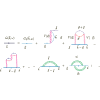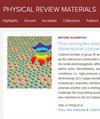Excitonic trion population in two-dimensional halide perovskites
IF 3.1
3区 材料科学
Q2 MATERIALS SCIENCE, MULTIDISCIPLINARY
引用次数: 0
Abstract
There are many reports of a surprisingly high charge-carrier density with sizable mobility in photoexcited two-dimensional (2D) halide perovskites despite their unusually high exciton binding energy. In this work we study the thermodynamic quasiequilibrium of the relative population of photoexcited free quasielectron/quasihole pairs, neutral excitons, and excitonic trions, in 2D materials that support such excitonic complexes with large binding energy. We derive and solve the general Saha equations which describe the detailed balance of such a system of photoexcited electronic degrees of freedom forming a multicomponent fluid of excitations in thermodynamic quasiequilibrium. The solution to these equations, for the special case of 2D perovskites where the reported exciton and excitonic trion binding energies are of the order of 0.3–0.4 eV for the former and 30–40 meV for the latter, reveals that while the charge-neutral excitonic population dominates all other excitations, at room temperature and below, the excitonic trion component can be the dominant population among charge carriers. We also argue that trionic hopping can take place via a tunneling mechanism which is speculated to play a role in a novel charge-transport mechanism.

二维卤化物过氧化物中的激子三离子群
尽管二维卤化物包晶石的激子结合能异常高,但有许多报告指出,在光激发二维卤化物包晶石中,电荷载流子密度出奇地高,并具有相当大的迁移率。在这项工作中,我们研究了支持这种具有高结合能的激子复合物的二维材料中,光激发自由准电子/准空穴对、中性激子和激子三离子的相对数量的热力学准平衡。我们推导并求解了一般萨哈方程,该方程描述了这种光激发电子自由度系统在热力学准平衡状态下形成多组分激发流体的详细平衡情况。在二维包晶的特殊情况下,前者的激子和激子三离子结合能分别为 0.3-0.4 eV 和 30-40 meV,这些方程的求解结果表明,虽然电荷中性的激子群在所有其他激子中占主导地位,但在室温及室温以下,激子三离子成分可以成为电荷载流子中的主导群。我们还认为,三离子跳变可以通过隧道机制发生,据推测,隧道机制在新型电荷传输机制中发挥了作用。
本文章由计算机程序翻译,如有差异,请以英文原文为准。
求助全文
约1分钟内获得全文
求助全文
来源期刊

Physical Review Materials
Physics and Astronomy-Physics and Astronomy (miscellaneous)
CiteScore
5.80
自引率
5.90%
发文量
611
期刊介绍:
Physical Review Materials is a new broad-scope international journal for the multidisciplinary community engaged in research on materials. It is intended to fill a gap in the family of existing Physical Review journals that publish materials research. This field has grown rapidly in recent years and is increasingly being carried out in a way that transcends conventional subject boundaries. The journal was created to provide a common publication and reference source to the expanding community of physicists, materials scientists, chemists, engineers, and researchers in related disciplines that carry out high-quality original research in materials. It will share the same commitment to the high quality expected of all APS publications.
 求助内容:
求助内容: 应助结果提醒方式:
应助结果提醒方式:


